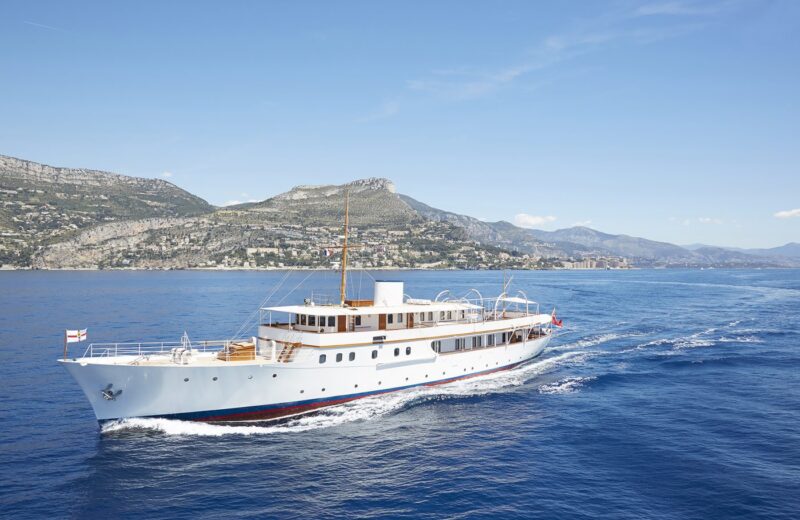Flagship: Old is gold, or is it?

Classic yachts, like classic cars or steam locomotives, are a labour of love to own or operate. Owners typically have owned a range of sailing yachts or motor cruisers previously and generally have a passion for the sport and historic vessels. So what puts people off classic vessels and what are the upsides to owning a yacht 40 years plus in age?
The area is a niche in the market which is dominated by classic sailing yachts, although there are various large motor yacht exceptions, including the 1929, 66.4m, German-built Don Amelia or the 1931, 77.5m, Danish-built Dannebrog. In fact, VesselsValue has 1,275 yachts in its database 40 years or older, of which 908 are motor craft and 367 sail.
According to William MacLachlan, partner HFW, many of the same issues apply to classic yacht ownership as apply to owning a large, modern yacht, “only they can often be a more serious labour of love and considerably more expensive to run than a modern vessel of their size”.
‘Serious labour of love’
The fiscal and operational advantages are few, indeed the heavy maintenance and responsibility of being custodian of a classic vessel can be off putting to some. Some classic yachts are even protected by, for example a national historic ships register such as National Historic Ships Register UK, but maintaining a classic yacht is not generally as restrictive as owning a listed property.
“That said, their often-smaller size and older building materials can cause difficulties when trying to comply with modern coding requirements and many do not meet the more stringent commercial code requirements of the leading yacht registries,” said MacLachlan.
“However, there are more flexible flag states available and often equivalences can be found. Specialist surveyors, technical consultants and builders can work with Class and flag state to deal with most coding issues.”
The one possible fiscal advantage MacLachlan offers is that a historic yacht may benefit from a deemed VAT paid status if it was in use as private pleasure craft prior to January 1st 1985 and in the EU on December 31st 1992.
“However, this should not be taken for granted as there are a number of reasons why in the period since then a yacht might have lost the benefit of such amnesty. Careful due diligence should be undertaken by anyone looking to rely on it.”
Age depreciation no longer a factor
Also, classic yachts are unique in that age depreciation is no longer a factor when it comes to value. Instead, the condition of the vessel has a much greater impact. VesselsValue, head of superyachts, Sam Tucker, explained: “For this reason, algorithms are currently inappropriate for valuing these older vessels. If the condition of the vessel were to improve over time as a result of work being completed, then the vessel would appear to appreciate in value. However, the value gained is unlikely to be greater than the cost of the completed work.
Tucker added: “These assets should not be seen as an investment for monetary gain, rather, the payoff is the pleasure derived from ownership.”
The sustainability of classic yachts could well be a concern for any potential owner. However, Tucker said a lot of classic yachts will often have modern engines or have their engines completely overhauled, so may not be emitting much more than a modern vessel.
“Also, classic yachts mostly have displacement hull forms. This means they travel at lower speeds and have a decreased fuel burn compared to vessels travelling at planing speeds. A modern yacht with modern engines in planing mode is likely to still burn more fuel per mile than older engines on older vessels travelling at a lower speeds.”
Appeals to different kind of owner
There is also an argument for extending the life of older vessels and forgoing the environmental externalities associated with manufacturing a completely new vessel. In that light classic yachts are often refitted and updated throughout their lifespan both to meet an owner’s liking and meet modernising standards. One yard which specialises in refitting classic vessels is Pendennis Shipyard.
In 2015, Pendennis refitted the 53m Malahne (pictured above) launched originally in 1937 by Camper & Nicholsons. Malahne boasts some serious history, not only was she used in the evacuation of Dunkirk in 1940, the vessel also acted as the production headquarters for the filming of the iconic Lawrence of Arabia.
Some owners want a new-build but they want to keep it classic. In 2018, Pendennis launched the 128ft sloop Vijonara after an 18 month build in its Falmouth yard. Vijonara was built using 3D scanning to ensure high levels of precision in the yacht’s symmetry.
Her designer, Andre Hoek, said, “The vessel was created for knowledgeable clients with extensive sailing experience. Based on a proven hull specification, the owners had a distinct vision for her customisation to suit their lifestyle and she has been optimised extensively for performance”.
‘Possess something truly unique’
Toby Allies, joint MD, Pendennis, told SYI: “Owning a classic yacht comes with the benefit of possessing something truly unique. When our clients enter a marina they know that they have something that is a one-off and stands out from the crowd. There’s a real sense of prestige, romance, history and responsibility that goes alongside owning a classic yacht that can’t be replicated in her modern contemporaries.”
Pendennis has an in-house team of 400 craftspeople and support staff who can do everything from the keel up. They have replaced thousands of tonnes of steel work, repaired and restored classic interiors and decks, overhauled original engines, removed contemporary additions and returned them to their original form and removed and upgraded interior systems to comply with modern yachting safety standards. “At Pendennis we are very aware of the responsibility that falls upon us to modernise and optimise these classic yachts whilst respecting their heritage.”
Classic yachts appeal to a different kind of owner and, as Tucker notes, historical designs are not optimised for modern usage. “As anyone with an interest in classic cars knows – there is always an endless work list, so maintenance costs are likely to be higher.”
Despite landing some blows in the classic versus modern standoff, there are a variety of negatives which could arise from ownership. These include higher maintenance and operations costs, low chance of value appreciation, higher insurance costs and the possibility of heritage protection.
That being said, MacLachlan puts its best: “Putting aside all of the above, for some owners, the labour of love and the opportunity to sail and care for an iconic classic yacht is the main attraction and worth the outlay and inconvenience.”
Subscribe to our free newsletter
For more opinions from Superyacht Investor, subscribe to our email newsletter.

